|
Main Pages
Front Page
Overview
Seal FAQs
Design Process
1st Committee
2nd Committee
3rd Committee
Final Design
Description
Explanation
Latin Mottoes
E Pluribus Unum
Annuit Coeptis
Novus Ordo Seclorum
Symbols (front)
Bald Eagle
Shield
Olive Branch
Arrows
Stars
Rays of Light
Cloud
Symbols (back)
Pyramid
Eye
MDCCLXXVI
Great Seals
Official Dies
First Engravings
First Painting
1792 Medal
Indian Medals
1882 Medal
One-Dollar Bill
Myths
Eagle Side
Pyramid Side
Themes
Unity
Peace
Liberty
Song by Tom Paine
West Coast Monument
Thirteen
Related
Wild Turkey
President's Seal
Sightings
Resources
Videos
Liberty Tree Song
United Seal
Make America
Bright Again
|
How the Great Seal Symbolizes Liberty and Freedom
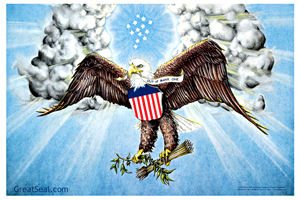
When Charles Thomson made the Bald Eagle the centerpiece of the Great Seal, he said it was "an American Eagle on the wing and rising." Whereas preliminary designs used the Goddess Liberty, Thomson chose the Eagle to symbolize liberty, freedom, and independence.
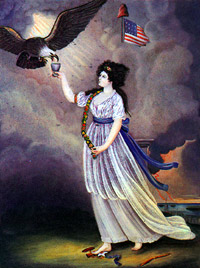 Thomson emphasized "Independence" by explaining that the shield is "born on the breast of an American Eagle without any other supporters, to denote that the United States of America ought to rely on their own Virtue."
Thomson emphasized "Independence" by explaining that the shield is "born on the breast of an American Eagle without any other supporters, to denote that the United States of America ought to rely on their own Virtue."
Prior to 1782, the Bald Eagle was rarely used as a symbol in America, but it quickly captured the public's interest. Americans took their national bird to heart, and it became popular in sculpture and art – often as the companion of Lady Liberty.
All three preliminary designs for the Great Seal emphasized the theme of liberty – usually represented as a female figure in various guises.
|
First Committee (1776)
"The Goddess Liberty" supported the shield on one side. She wore "a corslet of armour alluding to the present Times" and held her "Spear & Cap."
Second Committee (1780)
On the reverse side, Liberty is seated in a chair holding an olive branch and her staff with a Liberty cap on top of it. At first the motto was Semper Libertas Virtute perennis, which means "Liberty everlasting because of (or by reason of) virtue." (This was shortened to Virtute perennis – "Everlasting because of virtue.")
The Latin word virtute is a form of virtus which originally meant manliness, strength, or bravery. It came to also mean excellence, moral worth, or virtue.
Third Committee (1782)
On the shield is a pillar topped by a "Phoenix in Flames" which was described as being "emblematical of the expiring Liberty of Britain, revived by her Descendants, in America." The accompanying motto, In Vindiciam Libertatis, means "In Defense of Liberty."
|

Thomas Paine wrote a song about a gift from the Goddess of Liberty.
See his lyrics and listen to a rousing rendition from 1975.
Liberty and the Eagle
Liberty holds the Constitution of the United States with the American Eagle at her side (below left). They originally stood above the Speaker's desk of the House of Representatives in 1819.
The Genius of America and the Bald Eagle (below right) are on the centerpiece of the sculptural pediment over the east central entrance to the U.S. Capitol building.

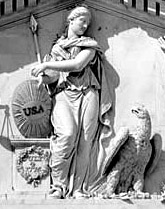
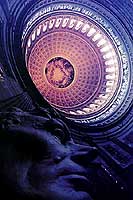 High above Abraham Lincoln, in the Dome of the U.S. Capitol Rotunda (America's equivalent of the ceiling of the Sistine Chapel), Liberty and the Eagle join other heroic figures in the Apotheosis of Washington.
High above Abraham Lincoln, in the Dome of the U.S. Capitol Rotunda (America's equivalent of the ceiling of the Sistine Chapel), Liberty and the Eagle join other heroic figures in the Apotheosis of Washington.
"Liberty relies upon itself, invites no one, promises nothing,
sits in calmness and light, is positive and composed,
and knows no discouragement." – Walt Whitman, Leaves of Grass
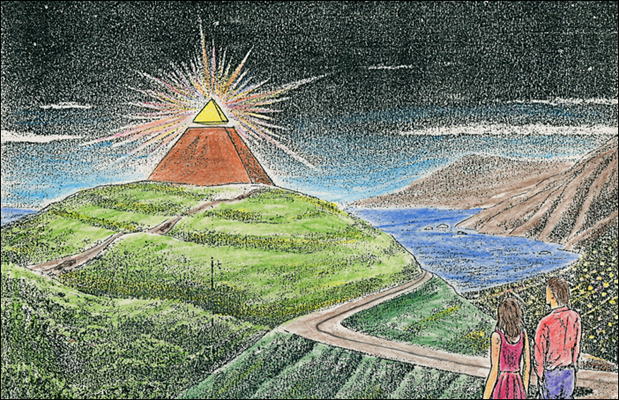
A west coast gateway monument (1988)
The image of Liberty feeding the eagle (near the top of this page) is a painting on glass by Abijah Canfield from Connecticut (c. 1800). It is based on the famous steel engraving by Edward Savage titled: "Liberty in the Form of the Goddess of Youth Giving Support to the Bald Eagle" (1796).
|

